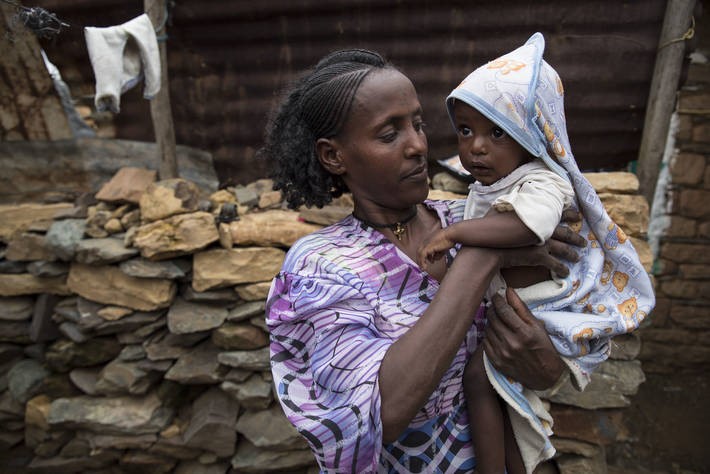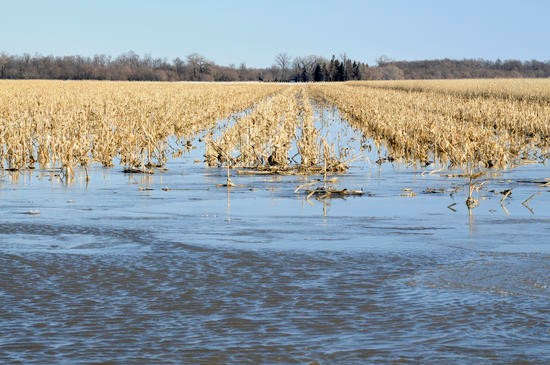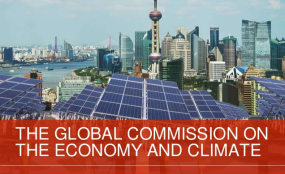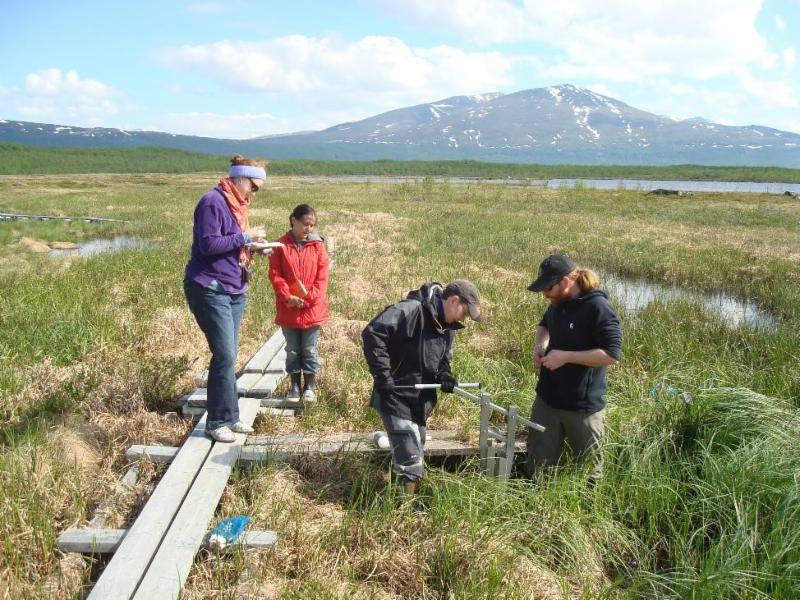Climate Variability Key Driver in Continuing Rise
of Global Hunger: UN Report
Climate variability affecting rainfall patterns and agricultural seasons, and climate extremes such as droughts and floods, are among the key drivers behind a continuing rise in hunger around the world, according to The State of Food Security and Nutrition in the World 2018.
 Released Sept. 11, the report offers new evidence that continues to signal the number of hungry people in the world is growing, reaching 821 million in 2017, or one in every nine people,
Released Sept. 11, the report offers new evidence that continues to signal the number of hungry people in the world is growing, reaching 821 million in 2017, or one in every nine people,
Conflict and economic slowdowns are also cited as factors in the ongoing rise in hunger.
Changes in climate are already undermining production of major crops such as wheat, rice and maize in tropical and temperate regions and, without building climate resilience, this is expected to worsen as temperatures increase and become more extreme, the UN analysis says.
The report also indicates that limited progress is being made in addressing the multiple forms of malnutrition, ranging from child stunting to adult obesity, putting the health of hundreds of millions of people at risk.
Hunger has been on the rise over the past three years, returning to levels from a decade ago. The reversal in progress sends a clear warning that more must be done and urgently if the UN Sustainable Development Goal of Zero Hunger is to be achieved by 2030.
The situation is worsening in South America and most regions of Africa, while the decreasing trend in undernourishment that characterized Asia seems to be slowing down significantly.
"The alarming signs of increasing food insecurity and high levels of different forms of malnutrition are a clear warning that there is considerable work to be done to make sure we 'leave no one behind' on the road towards achieving the SDG goals on food security and improved nutrition," the heads of the UN Food and Agriculture Organization (FAO), the International Fund for Agricultural Development (IFAD), the UN Children's Fund (UNICEF), the World Food Program (WFP) and the World Health Organization (WHO) warned in their joint foreword to the report.
"If we are to achieve a world without hunger and malnutrition in all its forms by 2030, it is imperative that we accelerate and scale up actions to strengthen the resilience and adaptive capacity of food systems and people's livelihoods in response to climate variability and extremes," the leaders said.
Analysis in the report shows that the prevalence and number of undernourished people tend to be higher in countries highly exposed to climate extremes. Undernourishment is higher again when exposure to climate extremes is compounded by a high proportion of the population depending on agricultural systems that are highly sensitive to rainfall and temperature variability.
Temperature anomalies over agricultural cropping areas continued to be higher than the long-term mean throughout 2011-2016, leading to more frequent spells of extreme heat in the last five years. The nature of rainfall seasons is also changing, such as the late or early start of rainy seasons and the unequal distribution of rainfall within a season.
The harm to agricultural production contributes to shortfalls in food availability, with knock-on effects causing food price hikes and income losses that reduce people's access to food.
The report also calls for greater efforts to build climate resilience through policies that promote climate change adaptation and mitigation, and disaster risk reduction.
The report also calls for implementing and scaling up interventions aimed at guaranteeing access to nutritious foods and breaking the intergenerational cycle of malnutrition. Policies must pay special attention to groups who are the most vulnerable to the harmful consequences of poor food access: infants, children aged under five, school-aged children, adolescent girls, and women.
At the same time, a sustainable shift must be made towards nutrition-sensitive agriculture and food systems that can provide safe and high-quality food for all, the report states.
Climate-Induced Soil Changes May Cause More Erosion, Flash Flooding
A study by a UC Riverside-led team of researchers predicts a climate-induced reduction in large soil pores, which may intensify the water cycle and contribute to more flash flooding and soil erosion by the end of the 21st century.
 In a paper published Sept. 5 in Nature, the scientists studied the impact of climate change on macroporosity - the amount of large pores in the soil. Macropores, which are greater than 0.08 mm in diameter, allow water to be absorbed easily into the surrounding soil, where it can be used by plants, transport nutrients, and eventually make its way back into underground aquifers.
In a paper published Sept. 5 in Nature, the scientists studied the impact of climate change on macroporosity - the amount of large pores in the soil. Macropores, which are greater than 0.08 mm in diameter, allow water to be absorbed easily into the surrounding soil, where it can be used by plants, transport nutrients, and eventually make its way back into underground aquifers.
"It is important to predict the response of macroporosity to climate change because of its role in the water cycle, and ultimately in water scarcity, food security, human health and loss of biodiversity," said Daniel Hirmas, an associate professor in the UC Riverside Department of Environmental Sciences and lead author on the study.
Using a large database of soils collected over 50 years from across the continental United States, combined with atmospheric data from a network of weather stations, the researchers examined changes in macroporosity across a rainfall, temperature, and humidity gradient. They found macropores were more likely to develop in drier climates than humid climates, and that climate-related changes in macroporosity occur over shorter timescales than previously thought.
The researchers then used climate projections for the end of the 21st Century to predict that increasing humidity by 2080-2100 will reduce soil macroporosity in most regions of the U.S. (with the exception of the southern coastal plain, which comprises Alabama and Louisiana).
The consequences could be less infiltration of water into the ground, more surface runoff and erosion, and more flash flooding.
"This is the first study to show that the development of macropores is influenced by climate at short timescales and it reinforces the hypothesis that climate change will probably intensify the water cycle," Hirmas said. "Our results suggest that macroporosity should be incorporated into global climate models to better understand the water cycle, anticipate changes, and prepare for the future."
The title of the paper is "Climate-induced changes in continental-scale soil macroporosity may intensify water cycle." In addition to Hirmas, authors include Daniel Giménez from Rutgers University; Attila Nemes from the Norwegian Institute of Bioeconomy Research (NIBIO); Ruth Kerry from Brigham Young University; and Nathaniel A. Brunsell and Cassandra J. Wilson from the University of Kansas. The work was funded by the United States Department of Agriculture's Agriculture and Food
Bold Climate Action Could Deliver $26 Trillion to 2030: Global Commission
A major report released by the Global Commission on the Economy and Climate finds that the economic benefits of cleaner, climate-smart growth are being seriously underestimated, claiming that bold climate action could deliver at least $26 trillion in economic benefits through to 2030, compared with business-as-usual.
 The report finds that over the last decade there has been tremendous technological and market progress driving the shift to a new climate economy.
The report finds that over the last decade there has been tremendous technological and market progress driving the shift to a new climate economy.
"There are real benefits to be seen in terms of new jobs, economic savings, competitiveness and market opportunities, and improved wellbeing for people worldwide," the commission says in a press release. "Momentum is building behind this shift by a wide range of cities, governments, businesses, investors and others around the world, but it is not yet fast enough."
"We are at a unique "use it or lose it" moment", said Ngozi Okonjo-Iweala, former finance minister of Nigeria and co-chair of the Global Commission. "Policy makers should take their feet off the brakes, send a clear signal that the new growth story is here and that it comes with exciting economic and market opportunities. On offer are $26 trillion and a more sustainable planet, if we act decisively now."
"The momentum from businesses, states, cities, investors and citizens is now unstoppable, not least because those taking bold climate action are already seeing tangible benefits," said Unilever CEO Paul Polman, co-chair of the Global Commission. "But if we are to unlock the full benefits of this new low carbon growth opportunity and avoid runaway climate change, economic and financial leaders in both government and the private sector need to do even more, and fast."
The report highlights opportunities in five key economic systems - energy, cities, food and land use, water, and industry. The commission says it demonstrates that ambitious action across these systems could deliver net economic gains compared with business-as-usual and:
- Generate over 65 million new low-carbon jobs in 2030, equivalent to today's entire workforces of the UK and Egypt combined.
- Avoid over 700,000 premature deaths from air pollution in 2030.
- Generate, through just subsidy reform and carbon pricing, an estimated $2.8 trillion in government revenues per year in 2030 - equivalent to the total GDP of India today -funds that can be used to invest in other public priorities or reduce distorting taxes.
The commission calls on governments, business and finance leaders to urgently prioritize actions on four fronts over the next 2-3 years:
- Ramp up efforts on carbon pricing and move to mandatory disclosure of climate-related financial risks;
- Accelerate investment in sustainable infrastructure;
- Harness the power of the private sector and unleash innovation; and
- Build a people-centered approach that shares gains equitably and ensures that the transition is just.
"The purpose of this report is to demonstrate how to accelerate the shift to this new growth path," said Helen Mountford, program director of the New Climate Economy and lead author of the report. "It lays out the benefits of doing so, the challenges ahead, and the clear accelerators or actions that can be taken to fully reap the rewards of stronger, cleaner, and more equitable growth.""
Former President of Mexico Felipe Calderon, honorary chair of the commission, said the document "is more than just a Report. It is a manifesto for how we can turn better growth and a better climate into reality. It is time we decisively legislate, innovate, govern and invest our way to a fairer, safer more sustainable world."
Research: U.S. Among Top Nations to Suffer
Economic Damage from Climate Change
For the first time, researchers have developed what they say is a data set quantifying what the social cost of carbon - the measure of the economic harm from carbon dioxide emissions - will be for the globe's nearly 200 countries, and the results are surprising.
Although much previous research has focused on how rich countries benefit from the fossil fuel economy, while damages accrue primarily to the developing world, the top three counties with the most to lose from climate change are the United States, India and Saudi Arabia.
The world's largest CO2 emitter, China, also places in the top five countries with the highest losses.
The findings, which appear in Nature Climate Change, estimate country-level contributions to the social cost of carbon (SCC) using recent climate model projections, empirical climate-driven economic damage estimations and socioeconomic forecasts. In addition to revealing that some countries are expected to suffer more than others from carbon emissions, they also show the global social cost of carbon is significantly higher than the one most used by the U.S. government to inform policy decisions.
Among the most-trusted contemporary estimates of the SCC are those calculated by EPA. The latest figures for global costs range from $12 to $62 per metric ton of CO2 emitted by 2020. However, the new data shows the SCC to be approximately $180-$800 per ton of carbon emissions.
What's more, the country-level SCC for the United States alone is estimated to be about $50 per ton - higher than the global value used in most regulatory impact analyses. This means that the nearly five billion metric tons of CO2 the U.S. emits each year is costing the U.S. economy about $250 billion, the research shows.
"We all know carbon dioxide released from burning fossil fuels affects people and ecosystems around the world, today and in the future," said lead author, University of California San Diego assistant professor Kate Ricke. "However these impacts are not included in market prices, creating an environmental externality whereby consumers of fossil fuel energy do not pay for and are unaware of the true costs of their consumption."
Ricke, who holds joint appointments with the campus's School of Global Policy and Strategy and Scripps Institution of Oceanography, said that "evaluating the economic cost associated with climate is valuable on a number of fronts, as these estimates are used to inform U.S. environmental regulation and rulemakings."
For example, claims that carbon dioxide causes relatively little harm to the economy can more easily justify rollbacks on environmental regulation.
In order to model the effects of CO2 emissions on country-level temperatures, the authors use an innovative approach by combining results from several climate and carbon cycle modeling experiments to capture the magnitude and geographic pattern of warming under different greenhouse gas emission trajectories, and the carbon-cycle and climate system response to carbon emissions.
Since carbon dioxide is a global pollutant, previous analysis has focused on the global social cost of carbon. However, the study's presentation of a country-by-country breakdown of the economic damage climate change will cause is important for various reasons.
The findings point to some paradoxical behavior in the climate governance arena. While the European Union has been an international leader on climate issues, the research shows the threat levels of future warming to be much higher for counties such as the United States and India. These nations might be expected to take a leadership role on climate, which, historically, has not been the case.
The authors conclude that many countries have not yet recognized the risk posed by climate change. Yet, they say a clearer understanding of domestic impacts may play a role in incentivizing nations to join forces to act, in their own self-interest, to mitigate climate change.
Key to Climate Stabilization Could Be Buried
Deep in the Mud, FSU Study Suggests
Earth's peatland soils store a lot of carbon - about as much as currently flows freely through the atmosphere as carbon dioxide. As global temperatures rise, scientists worry that the planet's grip on these carbon reservoirs could weaken, unleashing a "carbon bomb" that could further destabilize Earth's climate systems.
 But a new study led by Florida State University offers some hope that Earth's carbon reservoirs might not be quite as vulnerable as experts predict. In a global survey of peatlands - areas defined by soil-like, partially decomposed organic matter - researchers found signs that these carbon-rich environments could show some level of long-term resilience even as temperatures continue to climb.
But a new study led by Florida State University offers some hope that Earth's carbon reservoirs might not be quite as vulnerable as experts predict. In a global survey of peatlands - areas defined by soil-like, partially decomposed organic matter - researchers found signs that these carbon-rich environments could show some level of long-term resilience even as temperatures continue to climb.
"There's a lot of concern about losing these carbon reservoirs, but what this study suggests is that they are more stable than we initially thought," said Jeff Chanton, the Robert O. Lawton Distinguished Professor of Oceanography. "This mutes the carbon bomb hypothesis. It's good news."
The findings were published in the journal Nature Communications.
Peat forms most frequently in the North, where cooler climes prevent organic matter from fully decomposing. But peatlands can also be found in the tropics, where warm weather facilitates rapid decomposition.
This puzzled a team of researchers from FSU's Departments of Chemistry and Biochemistry and Earth, Ocean and Atmospheric Science. If tropical peatlands can successfully withstand equatorial temperatures, they asked, might northern peatlands also have the capacity to stabilize in warmer conditions?
To investigate, the team collected peat samples from a globally representative selection of far-flung sites - subarctic Swedish mires, temperate North Carolina bogs and tropical Bornean peat swamps to name a few. They then used advanced spectroscopy tools to investigate the unique chemical profiles of their samples.
The team quickly identified significant chemical differences between peat sourced from higher and lower latitudes.
"Peat from warm climates had lower concentrations of carbohydrates and higher concentrations of aromatics compared to peat from colder climates," said former FSU postdoctoral researcher Suzanne Hodgkins, who led the study.
Cold-climate peat, with its higher carbohydrate concentration, is considered by scientists to be more labile, or more easily degradable. As temperatures increase, the carbohydrates in the peat decompose and carbon dioxide is emitted.
Warm-climate peat sampled from lower latitudes, on the other hand, was found to be largely depleted of carbohydrates. Instead, these samples contained high levels of aromatics - stable chemical compounds left behind by decomposed plant matter.
As temperatures rise at higher latitudes, northern peatlands will burn off their surface store of carbohydrates, releasing carbon dioxide into the atmosphere. The key to what happens next lies in the chemistry of the peat buried deep below the Earth, said Hodgkins, now a postdoctoral researcher at Ohio State University.
"The long-term stability of northern peat in the face of warming depends on whether it can develop a chemistry similar to tropical peats," she said "Initially, northern peat will likely decompose and release carbon into the atmosphere, but eventually this decomposition will reduce the abundance of carbohydrates relative to aromatics. This change in chemistry could stabilize the remaining peat against further decomposition."
If, after the initial carbohydrate burn, northern peatlands come to more closely resemble their southern counterparts - which have endured in warm weather for millennia - then their aromatic-dominant chemistry could act as a bulwark against further decomposition and carbon dioxide release.
"Evidence from the study suggests that northern peatlands may develop many of the same compositional features as southern peatlands, mitigating to some extent the potential for substantial carbon losses to the atmosphere," said retired Professor of Analytical and Environmental Chemistry Bill Cooper, who helped direct the study.
This mitigation is contingent on the rate of carbohydrate decomposition and the ways northern plant ecology adapts to warmer temperatures, but it could play a major role in preventing considerable amounts of carbon dioxide from reaching an already-warming atmosphere.
However, while stable peatlands may help avert worst-case scenarios and temper the dreaded carbon bomb, researchers said these kinds of ecological restraints on warming are not enough to reverse global climate trends.
"All of these natural processes pale in comparison to the rate at which human beings are releasing fossil fuel CO2 into the atmosphere," Chanton said. "We're releasing CO2 at enormous rates, so this is not going to save us."
States, Cities, Businesses Leading U.S. to Paris Emission Goals
States, cities, businesses and other "real-economy actors" have enabled the United States to get almost halfway to the original target commitment - a of 26-28 percent below 2005 levels by 2025 - made under the 2015 Paris Climate Agreement, says a study, Fulfilling America's Pledge released at the Global Climate Action Summit Sept. 12-15 in San Francisco.
 The America's Pledge initiative was established by former New York City Mayor and United Nations Special Envoy for Climate Action Michael R. Bloomberg and California Governor Edmund G. Brown, Jr. to aggregate, analyze, and showcase climate leadership by America's states, cities and businesses.
The America's Pledge initiative was established by former New York City Mayor and United Nations Special Envoy for Climate Action Michael R. Bloomberg and California Governor Edmund G. Brown, Jr. to aggregate, analyze, and showcase climate leadership by America's states, cities and businesses.
The study says that current policies and existing pledges from real economy actors, along with market forces and technology change, will deliver economy-wide emissions reductions of 17 percent below 2005 levels by 2025, even accounting for economic and population growth.
But with broader engagement of states, cities and businesses, within realistic legal and political limits, there remains the potential to reduce U.S. emissions more than 24 percent below 2005 levels by 2025, the study says.
"This would be within striking distance of the Paris pledge, making the 2-perecent threshold achievable shortly thereafter," America's Pledge said in a statement. "Moreover, such action would drive an even faster rate of economy-wide decarbonization between 2025 and 2030."
Initiative leaders say that in the year since the Trump Administration announced its intent to withdraw from the Paris Agreement, over 3,000 real economy actors have pledged their support for the Paris Agreement and commitment to continued action on climate change by joining the "We Are Still In" declaration and participating in other networks such as the U.S. Climate Alliance and the Climate Mayors.
Between 2005 and 2016 - the latest U.S. Greenhouse Gas (GHG) Inventory - U.S. emissions declined by 12 percent, or nearly halfway to the lower bound of the emissions target under the Paris Agreement. The emission reduction occurred in tandem with overall economic growth of more than 18 percent during that same period.
In 2017, U.S. energy-related carbon dioxide emissions fell to the lowest levels in 25 years. Despite the Trump Administration's pro-coal policies, announced coal plant retirements are happening faster than ever before. Since June 1, 2017, the United States has added enough renewable energy to power more than 3 million homes for a year.
States accounting for 35 percent of the U.S. economy are expected to have a price on GHG pollution by the end of this year. And more than 70 U.S. companies have announced emissions targets in line with the Paris Agreement, initiative members say.
The economic activity of what the initiative is calling "coalition of the willing" is significant, equivalent to that of the third-largest country in the world. Specifically, the U.S. states, cities, businesses, and other leaders of the real economy that remain committed to the Paris Agreement represent more than half of the U.S. population (173 million people), at least half of the American economy ($11.4 trillion), and more than 35 percent of nationwide GHG emissions.
U.S. real economy actors are already cutting emissions and scaling clean energy, not just to address climate change but to help create economic opportunities and jobs, and to deliver immediate benefits to public health, initiative leaders say.
The report provides an updated survey of sector-specific actions across all 50 states, the largest 285 cities, and a wide number of businesses in order to assess the impact of climate actions. Among the key findings:
- States, cities, and counties with GHG emissions reduction targets already on the books could cut annual emissions by 500 million metric tons of carbon dioxide equivalent (Mt CO2e) from business-as-usual levels by 2025 if they are fully implemented;
- State, city, and business clean energy procurement policies (e.g. renewable portfolio standards) should increase demand for non-hydroelectric renewable generation to 500 terawatt-hours (TWh) by 2025 - enough to power 56 million homes for a year
- Energy efficiency policies enacted by states, cities, and utilities could result in annual energy savings of over 200 TWh per year by 2025;
- Implementation of zero-emissions vehicles (ZEVs) mandates would lead to having 4 million new ZEVs on the road by 2025;
- State and city commitments to sustainable transportation networks could cut annual vehicle miles traveled by 36 billion miles, compared with business-as-usual projections by 2025;
- State, city, and business initiatives to cut hydrofluorocarbon (HFC) emissions could reduce these emissions by 6 percent from 2015 levels by 2025; and
- Policies and corporate actions designed to address fugitive methane leaks from oil and gas operations could cut national emissions by 17 percent by 2025, relative 2005 levels.